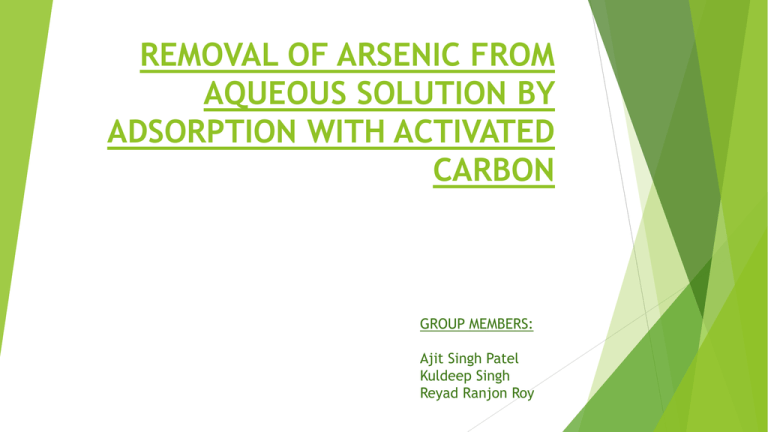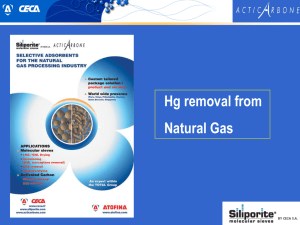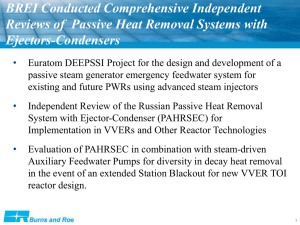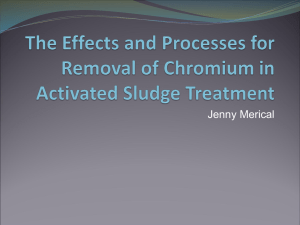Gp_Reyad
advertisement

REMOVAL OF ARSENIC FROM AQUEOUS SOLUTION BY ADSORPTION WITH ACTIVATED CARBON GROUP MEMBERS: Ajit Singh Patel Kuldeep Singh Reyad Ranjon Roy BACKGROUND AND OBJECTIVE: BACKGROUND: Sources of arsenic Why is its removal necessary? Methods for removal OBJECTIVE: Removal of arsenic upto permissible limit. Comparison of adsorption parameters Study the effect of modification, pH, temperature and presence of co-ions. Selection of efficient and economic method METHODS: The following types of activated carbon were used for : Adsorption capacity and Isotherm study Kinetic study pH change, temperature variation, presence of co-ions Coal derived activated carbon modified with NZVI Bituminous based, coconut coal and wood based activated carbon apricot stone based activated carbon hybrid adsorbents Activated carbons with iron hydro(oxide) nanoparticles Biomass waste (bean pods) derived activated carbon china calgon activated carbon Darco and norrit activated carbon Charcoal activated carbon Activated carbon from fibre cloths Activated carbon from pine wood sawdust FINDINGS: modification of AC by iron gives higher removal and reduction in regeneration frequency. rapid adsorption and better removal efficiency by modification with Fe+3 than Fe+2. amount of iron present in water affects adsorption capacity as when amount of Fe increases from 0 to 4.22% only then removal efficiency increases. Oxidised AC gives very rapid and efficient removal upto less than 10 microgram/L As content. the activated carbon, with higher value of ash content , was more effective in removing As(V) . Biomass(bean pods) derived AC provides very cheap removal of As(III). This type of AC have higher efficiency than other for same specific Area . Generally maximum adsorption capacity is found between pH 6-8 ,but bituminous waste and coconut husk based AC gives maximum adsorption capacity at pH 11. coal derived AC which is modified with NZVI particles is superior for removal of As(III) in available pH conditions for natural water. Charcoal based AC is found to be best for the removal of As(V) in pH range from 6 to 8. SO42- and Cl- have more affinity to AC than arsenic. Presence of common divalent cation like Mg+2,Ca+2 and Fe+2 increases the removal % of arsenate whereas presence of Ag+ and Cu+ increases the removal % of As(III) but decreases the removal % of As(V) considerably . Adsorption by Fe+2 modified AC is endothermic while Adsorption by Fe+3 modified AC is found exothermic in case of apricot based AC. Some AC shows insignificant change in adsorption capacity with temperature variation. Issues and directions for further research For economic new waste produced materials such as from nutshell, peat etc. should be used for the production of AC. New modification method should introduce because Modified activated carbon has more adsorption capacity than virgin activated carbon. REFERENCES: B K Mandal, Kazuo T. Suzuki, Arsenic round the world: a review, Graduate School of Pharmaceutical Sciences, Chiba Uniersity, Chiba 263 -8522, Japan. US EPA. Minor clarification of National Primary Drinking Water Regulation for arsenic. Proposed rule. Fed Regist 2002;67(246):78203–9. A.M. Raichur, V. Panvekar, Removal of As(V) by adsorption onto mixed rare earth oxides, Sep. Sci. Technol. 37 (5) (2002) 1095– 1108. S. Goldberg, Competitive adsorption of arsenate and arsenite on oxides and clay minerals, Soil Sci. Soc. Am. J. 66 (2) (2002) 413–421 M.-J. Kim, Separation of inorganic arsenic species in groundwater using ion exchange methods, Bull Environ. Contam. Toxicol. 67 (1) (2001) 46–51. R. Mamtaz, D.H. Bache, Reduction of arsenic in groundwater by coprecipitation with iron, J. Water Supply (2001) 313–324. R.C. Cheng, H.C. Wang, M.D. Beuhler, Enhanced coagulation for arsenic removal, J. Am. Water Works Assoc. 86 (9) (1994) 79– 90. Cornell RM, Schwertmann U. The iron oxide. 1st ed. New York: VCH Publishers; 1996. L. Cumbal, A.K. Sengupta, Arsenic removal using polymer-supported hydrated iron(III) oxide nanoparticles: role of Donnan membrane effect, Environ. Sci. Technol. 39 (2005) 6508–6515. Mohan D, Pittman Jr CU. Arsenic removal from water/wastewater using adsorbents – a critical review. J HazardMater 2007;142:1–53. A. Özge, E. Özdemir, E. Bilgin, U Beker, Removal of As(V) from aqueous solution by activated carbon-based hybrid adsorbents: Impact of experimental conditions, Chemical Engineering Journal 223 (2013) 116–128. G. Ghanizadeh, M.H. Ehrampoush, M.T. Ghaneian, Application of iron impregnated activated carbon for removal of arsenic from water, Iran. J. Environ. Health Sci. Eng. 7 (2010) 145–156. E. Deliyanni, T.J. Bandosz, K.A. Matis, Impregnation of activated carbon by iron oxyhydroxide and its effect on arsenate removal, J. Chem. Technol. Biotechnol.88 (2013) 1058–1066 K.D. Hristovski, P.K. Westerhoff, T. Möller, P. Sylvester, Effect of synthesis conditions on nano-iron (hydr)oxide impregnated granulated activated carbon, Chem. Eng. J. 146 (2009) 237–243 A.Ö.A. Tuna, E. Özdemir, E.B. Simsek, U. Beker, Removal of As(V) from aqueous solution by activated carbon-based hybrid adsorbents: impact of experimental conditions, Chem. Eng. J. 223 (2013) 116–128. Q. Chang, W. Lin, W.-C. Ying, Preparation of iron-impregnated granular activated carbon for arsenic removal from drinking water, J. Hazard. Mater. 184 (2010) 515–522. P. Lodeiro, S.M. Kwan, J.T. Perez, L.F. González, C. Gérente, Y. Andrès, G. McKay, Novel Fe loaded activated carbons with tailored properties for As(V) removal: adsorption study correlated with carbon surface chemistry, Chem. Eng. J. 215–216 (2013) 105–112. W. Chen, R. Parette, J. Zou, F.S. Cannon, B.A. Dempsey, Arsenic removal by ironmodified activated carbon, Water Res. 41 (2007) 1851–1858. S Zhang , X Li, J. Paul Chen, Preparation and evaluation of a magnetite-doped activated carbon fiber for enhanced arsenic removal, Carbon 48 (2010)60-67 Z. Gu, J. Fan, B. Deng, Preparation and evaluation of GAC-Based iron containing adsorbents for arsenic removal, Environ. Sci. Technol. 39 (2005) 3833–3843. H.Zhua, Y.Jia, X.Wua, H Wang, Removal of arsenic from water by supported nano zero-valent iron on activated carbon, Journal of Hazardous Materials 172 (2009) 1591–1596. Z Liua, F S Zhanga, R Sasaib, Arsenate removal from water using Fe3O4-loaded activated carbon prepared from waste biomass, Chemical Engineering Journal 160 (2010) 57–62 J.A. Arcibar-Orozco, D.B. Josue, J. C. R.Hurtado, J. R. R.Mendez , Influence of iron content, surface area and charge distribution in the arsenic removal by activated carbons, Chemical Engineering Journal 249 (2014) 201–209 A.Yürüm, Z.Ö. K.Atakli , M. Sezen , R. Semiat, Y.Yürüm, Fast deposition of porous iron oxide on activated carbon by microwave heating and arsenic (V) removal from water, Chemical Engineering Journal 242 (2014) 321–332. Q.L. Zhang, Y.C. Lin, X. Chen, N.Y.Gao, A method for preparing ferric activated carbon composites adsorbents to remove arsenic from drinking water, Journal of Hazardous Materials 148 (2007) 671–678. A.Ö.A.Tuna, E.Özdemir, E.Bilgin, U.Beker, Removal of As(V) from aqueous solution by activated carbon-based hybrid adsorbents: Impact of experimental conditions, Chemical Engineering Journal 223 (2013) 116–128. A.V.V.Rodriguez, J.R.R.Mendez, Arsenic removal by modified activated carbons with iron hydro(oxide)nanoparticles, Journal of Environmental Management 114 (2013)225e231 T. Budinova, D. Savova , B.Tsyntsarski, C.O. Ania, B. Cabal , J.B. Parra, N. Petrov, Biomass waste-derived activated carbon for the removal of arsenic and manganese ions from aqueous solutions, Applied Surface Science 255 (2009) 4650–465







